Yucca
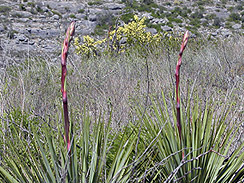
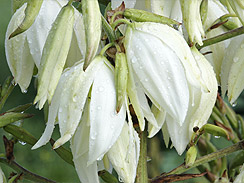
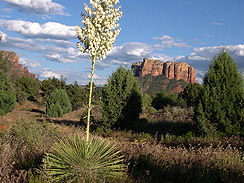
I think of yucca as Southwest manna. It’s one of the most useful and interesting plants, feels like a gift. Uses include food(!), soap, rope. Yucca comes in many varieties, and most have sharp-pointed thin woody leaves pointing outward from a cluster ball. The plant pushes out a tall thin shaft that will produce scads of blooms and seeds. Depending on the species, this happens yearly, occasionally, or only at the end of its life cycle. Spanish bayonet, the variety I see daily here in the hills, has long thin leaves about 1″ wide each with extremely sharp tips. One once gracefully slid 1″ into my knee cap, so be very very careful. This particular variety has a red stalk that looks very much like a giant woody asparagus, which produces dozens or even hundreds of white flowers. Though different yucca produce different colored blooms, the flower skin tends to be thick and almost leathery.
All parts of the plant are useful, and many parts are edible. Flowers, roots, stalks and hearts are all edible. Stalks can be eaten raw, boiled, sautéed, pickled or used in salads. Same goes for the flowers, which are often scrambled with eggs and sometimes breaded and fried. The starchy heart of the plant’s base can be roasted whole, but this requires killing the entire plant. To gather starch without killing the plant, pull leaves individually from the base, then scrape out white starch from 2-3 inches at the leaf’s base, where it connected to the heart.
Yucca makes great trail food. You can pop flowers in your mouth. The stalks can be skinned and eaten raw which tastes a lot like jicama, or slow roasted on campfire along with the heart and roots.
Use discretion when harvesting yucca. Harvest the entire plant and/or stalk sparingly, and only when growing plentifully in clusters. Yucca live in harsh terrain and support many forms of life. And a note of caution: be careful not to confuse yucca with agave when processing the plant, as agave leaf sap causes VERY painful skin irritation.
My Recipe: Yucca Stalk Salad with Tangy Mango
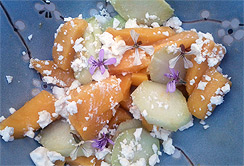
1 foot section of yucca stalk
3 very firm mangos, almost tough
1/2 small sweet red onion
1 small meyer lemon
2 tbsps olive oil
1/2 pound feta cheese
2 tbsps fresh fennel leaves
1 tbsp honey
salt
pepper
Remove any sharp spines from the shaft, then strip away the outer skin to reveal the sweet firm white core. Slice into 1/8″ circles, then cut into semi circles. Remove mango skins, then slice into 1/8″ pieces. Slice red onion paper-thin, then cut into 1″ sections, separating into single slivers. Coarsely chop fennel leaves. Place all ingredients in large bowl.
In smaller bowl, mix all other ingredients: juice of meyer lemon, honey, olive oil, salt and pepper to taste. Drizzle over salad and toss. Crumble feta in large chunks atop. Garnish with edible flowers from your garden (nastertium, wood sorrel, etc.).
My Recipe: Marinated Yucca Bud Salad
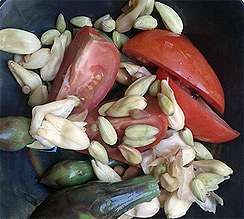
2 cups yucca flower buds
12 small cactus flower buds
6 roma tomatoes
8 black pepper corns
2 star anise
1 tbsp fresh grated ginger root
2-3 cups apple vinegar
1/4 cup brown sugar
Several days before consuming, you’ll need to cold pickle your ingredients. You can throw in some open yucca flowers too. Combine vinegar, star anise, brown sugar in small saucepan, bring to very low boil just long enough to dissolve sugar. Remove from heat and allow to cool for five minutes. Cut tomatoes into quarters, lengthwise. Place tomatoes, buds, ginger, and pepper corns in the smallest glass jar that will hold the vegis without squashing them. Pour vinegar while still very warm into glass jar, covering all other ingredients. If your buds or tomatoes decide to float on top of the liquid, find a way to keep them submerged. I used a small zip lock baggy, slightly inflated to push them down into the liquid. Allow to marinate in refrigerator several days before eating.
